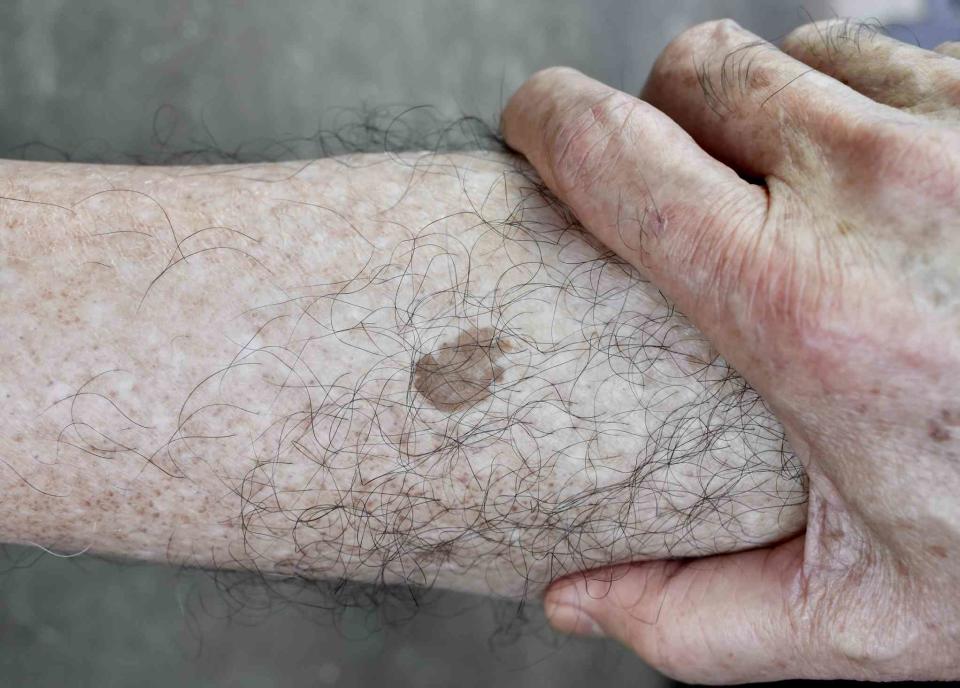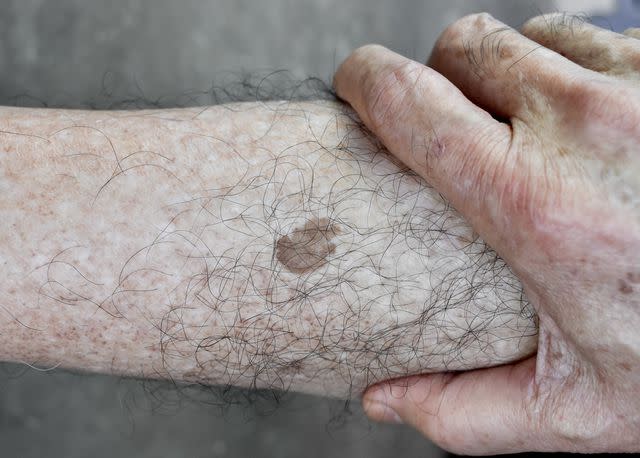Aging Spots on Legs: What’s Normal and What’s Not
The Appearance of Individual Spots or Clusters From Sun Exposure

Zay Nyi Nyi / Getty Images
Medically reviewed by Casey Gallagher, MD
Aging spots on the legs, also called age spots, liver spots, or solar lentigo, are a very common and normal part of aging. They look like large brown freckles and can show up almost anywhere that the skin experiences exposure to the sun.
Several methods are available to fade or remove aging spots. Some can be done at home, whereas others require a visit to a healthcare provider. This article will discuss how to identify an age spot, how to get it removed, and prevent future ones from appearing.

Zay Nyi Nyi / Getty Images
Are Aging Spots on Legs Normal?
Age spots on the legs are incredibly common and normal. They are especially common in people 40 years old and older. Areas of the body that are exposed to the sun, like the hands, face, arms, and legs, can develop aging spots.
Exposure to sunlight causes melanocytes (pigment-producing cells in the skin) to multiply. The pigment they produce (melanin) collects in the skin cells. resulting in an age spot.
If new spots are appearing on the skin and they do not fit the description of an age spot, talk to a healthcare provider. Several skin conditions look similar to an age spot.
While these spots are often called liver spots, they are named after the color only. They are not related to the health of your liver.
When to Be Concerned About Age Spots
Age spots are completely harmless, but they can resemble other skin conditions. Some of these are serious and need treatment, while others are benign. It is good to see a healthcare provider to ensure a proper diagnosis. These conditions include:
Melanoma in situ (skin cancer)
Pigmented actinic keratosis (precancerous spots)
Lichenoid keratosis (benign inflamed lesion)
Seborrhoeic keratosis (benign growths)
One of the main concerns regarding skin spots is that they could be skin cancer. Spots that are related to skin cancer can look:
Firm and red
Crusty
Bleeding
Scaly or rough
Shiny or waxy
Identifying Aging Spots on Legs
Age spots on the legs appear as tan or brown spots on the skin. They have the following features:
Defined edges
Rounded shape
Brown or black color
Flat against the skin
People at Risk of Age Spots
People with light-colored skin and frequent sun exposure are at greater risk of developing age spots. However, those with darker skin can also develop age spots.
Removing Aging Spots on Legs: What Are the Possibilities?
Age spots can be lightened or, in some cases, completely removed. There are many options when it comes to removing age spots. Before attempting to use any at-home remedies, talk to a healthcare provider. Ways age spots can be removed include the following:
Creams: Lightening creams that treat hyperpigmentation include hydroquinone cream (prescription-only). or a combination of creams that includes hydroquinone, tretinoin, and a low-potency topical steroid. Over-the-counter cysteamine cream also has been successfully used to treat age spots. It's applied daily for 15 minutes and generally takes six weeks to see results, with full results after eight to 12 weeks.
Laser: One or two laser treatments can quickly fade an age spot. The results will last longer than a cream. However, there are side effects like temporary age spot darkening or crusting that resolve quickly.
Cryosurgery: A healthcare provider freezes the age spot. When the skin heals, it can have a more even color. But it has temporary side effects that can include pain, a blister, redness, and swelling.
Microdermabrasion: A healthcare provider smoothes away age spots. The procedure may need to be repeated every two weeks for 16 weeks. It is sometimes used in conjunction with chemical peels for better results.
Chemical peel: A solution is applied to the skin to remove the age spot. This usually heals faster than cryosurgery.
Skin Care and Sun Protection With Aging Spots on Legs
Protecting the skin from sun exposure is the best way to prevent age spots. When outside, stay in the shade and cover the skin with sun-protective clothing. You can find garments available that are rated for sun protection.
To protect your head, face, eyes, and neck, wear a wide-brimmed hat and ultraviolet (UV) ray–protective sunglasses. On all exposed skin, wear broad-spectrum sunscreen with a sun protection factor (SPF) of 30 or higher and water resistance.
Even if aging spots have been treated, they can still return if good sun protection habits are followed.
Summary
Aging spots on the legs appear as people get older and with long-term sun exposure. They are harmless discolorations of the skin that occur when sun exposure stimulates pigment-producing cells in the skin.
It is good to see a healthcare provider to ensure the spots are not a more concerning skin condition, such as skin cancer or precancerous actinic keratosis. A healthcare provider can recommend the best way to have them faded or removed if desired. Removal can be done with creams, lasers, or a chemical peel.
Protect your skin to prevent age spots from forming by covering it with clothes, using sunscreen, and staying in the shade when outdoors.

